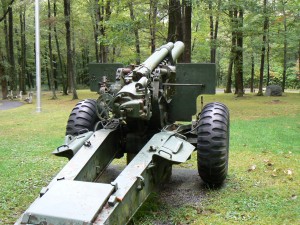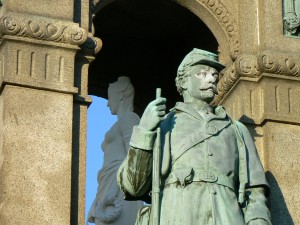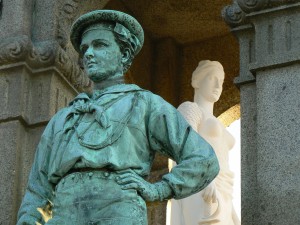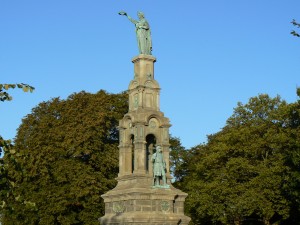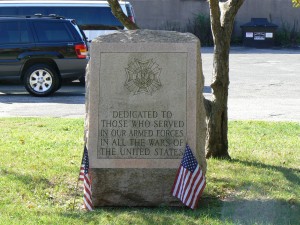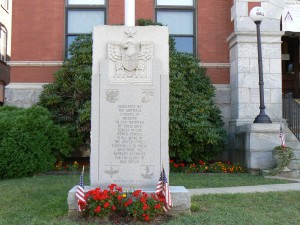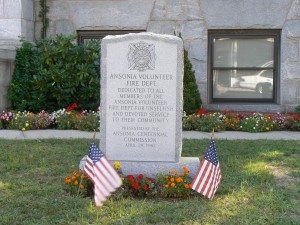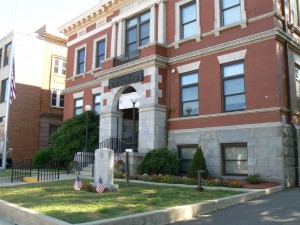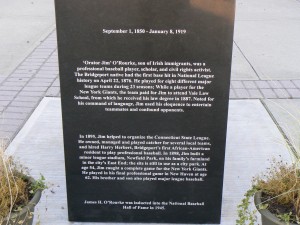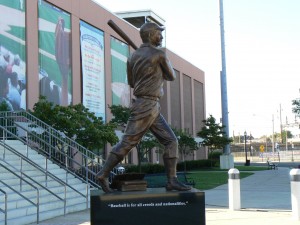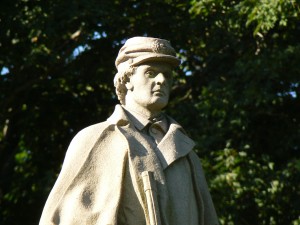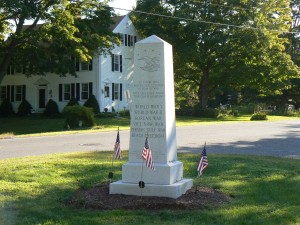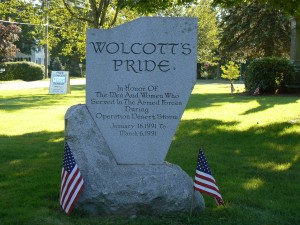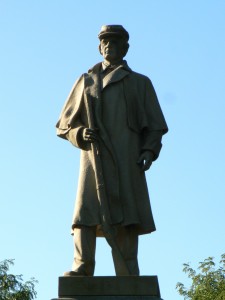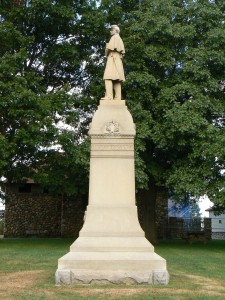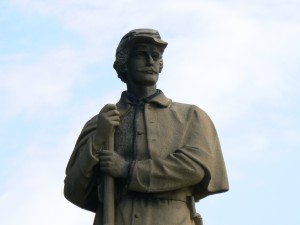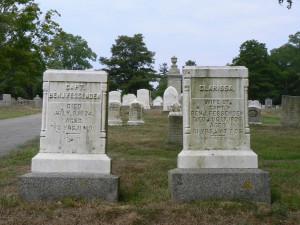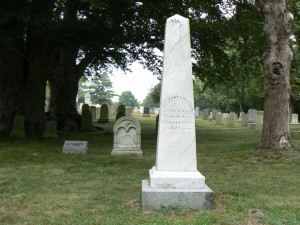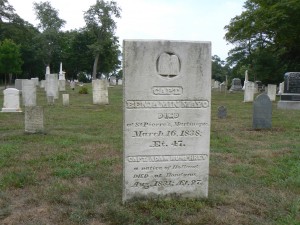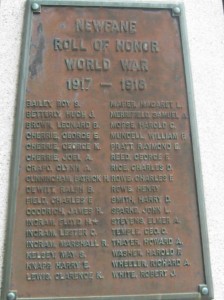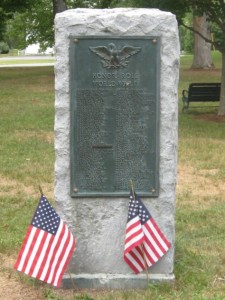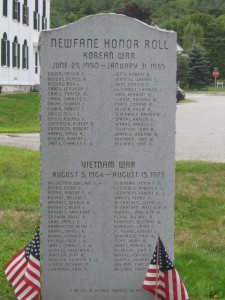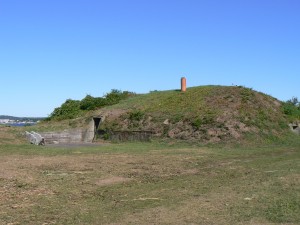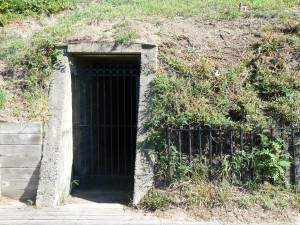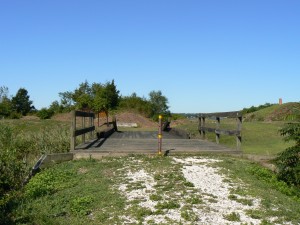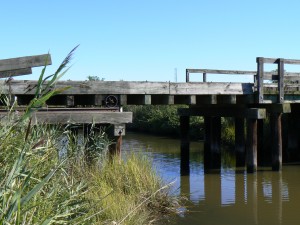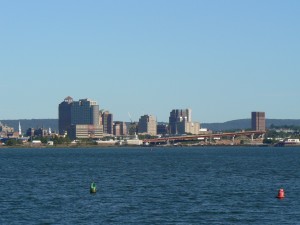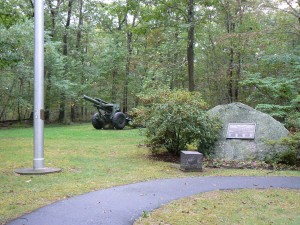 One of Trumbull’s town parks was donated to honor its World War II heroes.
One of Trumbull’s town parks was donated to honor its World War II heroes.
Robert G. Beach Memorial Park was dedicated in 1946 to honor Beach and the 21 other Trumbull residents lost in the war.
The park’s monument circle features a large boulder with a 1950 dedication plaque explaining that the park was donated by Beach’s parents to honor Trumbull’s World War II veterans. The plaque lists the 22 residents killed in the war.
Near the boulder is a 1951 flagpole that honors Richard F. Moore, Jr., an Army Air Corps lieutenant killed in Germany in 1944. The flagpole was donated by his family.
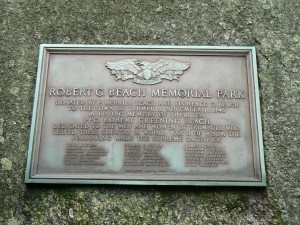 The monument circle also features a 155mm howitzer artillery piece. A 1994 plaque on the howitzer expresses a wish that someday all weapons of war will have their breaches and barrels welded shut.
The monument circle also features a 155mm howitzer artillery piece. A 1994 plaque on the howitzer expresses a wish that someday all weapons of war will have their breaches and barrels welded shut.
Land for the park was purchased by Beach’s parents from Bridgeport Hydraulic Company. Beach’s father, E. Merrill Beach, was a local banking executive who founded the Trumbull Historical Society and wrote three books about Trumbull’s history.
Trumbull’s World War II heroes are also honored on the war memorial in front of Town Hall.
Tags: Trumbull
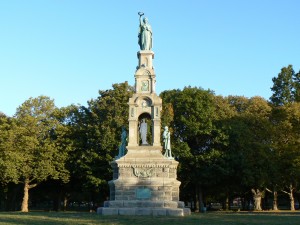 An allegorical representation of Liberty again graces the 1876 Soldiers’ and Sailors’ Monument in Bridgeport’s Seaside Park.
An allegorical representation of Liberty again graces the 1876 Soldiers’ and Sailors’ Monument in Bridgeport’s Seaside Park.
Thanks to the Friends of Seaside Park, a replica of a six-foot marble statue representing Liberty was dedicated on Saturday morning at the monument honoring Bridgeport’s Civil War veterans.
The original marble statue was removed in the late 1960s after deterioration and vandalism had taken their toll.
The replacement, by Vermont sculptor Emily Bedard, was created using white gypsum polymer and fiberglass.
The return of Lady Liberty completes a restoration effort that began in 2006 with the installation of replacement plaques honoring the approximately 180 local residents killed in the war. Several missing decorative elements, such as the flags and drums near the monument’s base, were also replaced.
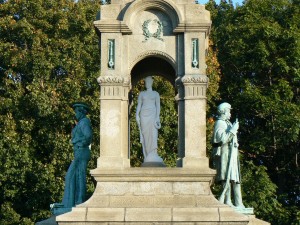 The monument features a large, granite base with several decorative elements that narrows into a shaft topped by a bronze allegorical figure representing the United States. The monument’s sides feature bronze statues depicting an infantry soldier and a sailor.
The monument features a large, granite base with several decorative elements that narrows into a shaft topped by a bronze allegorical figure representing the United States. The monument’s sides feature bronze statues depicting an infantry soldier and a sailor.
The three bronze figures were created by Melzar Mosman, who was also responsible for monuments in Middletown and Danielson, as well as the figures on the monument in New Haven’s East Rock Park.
The monument stands on the former training fields of the 17th Regiment of the Connecticut Volunteer Infantry.
Our original (and now outdated) post describing the monument and the missing Liberty statue appeared last summer.
Tags: Bridgeport
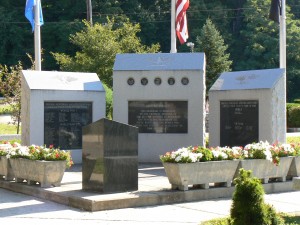 Ansonia honors veterans lost in the nation’s 20th Century Wars with a collection of monuments near City Hall.
Ansonia honors veterans lost in the nation’s 20th Century Wars with a collection of monuments near City Hall.
Veterans’ Memorial Park, immediately next to City Hall, features a large granite monument inset with three polished black granite panels. A dedication on the front (west) face of the monument’s central section reads, “This memorial is dedicated by the grateful citizens of the City of Ansonia to preserve and honor the memory of all those brave men and women who served our country so selflessly in time of conflict.”
The northern section of the monument, dedicated in 1999, honors “friends, neighbors and relatives” lost in the two World Wars. The monument lists the names of about 32 World War I heroes and about 70 who were killed in World War II.
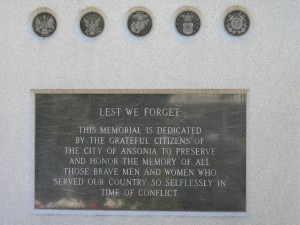 The southern panel honors two residents who died in the Korean War and nine who were killed in Vietnam.
The southern panel honors two residents who died in the Korean War and nine who were killed in Vietnam.
At the southern side of the park, a monument erected by the Veterans of Foreign Wars honors all U.S. war veterans.
In front of City Hall, a monument dedicated on Veterans’ Day in 1959 offers similar gratitude for the service of Ansonia’s war veterans, and praises those who made the supreme sacrifice.
Another monument to the south of the veterans’ memorial honors the service of Ansonia’s volunteer firefighters. The firefighter monument was dedicated in 1990.
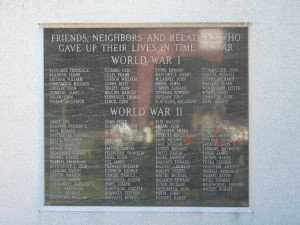 Ansonia’s World War II, Korea and Vietnam veterans from the Woodbridge Avenue neighborhood are further honored with an honor roll monument that traces its roots back to 1942.
Ansonia’s World War II, Korea and Vietnam veterans from the Woodbridge Avenue neighborhood are further honored with an honor roll monument that traces its roots back to 1942.
Ansonia’s Civil War veterans are honored with an 1876 monument in the city’s Pine Grove Cemetery.
Tags: Ansonia
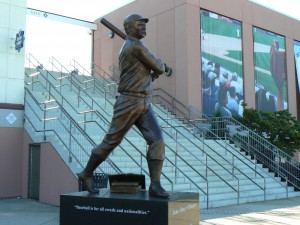 Bridgeport honors Hall-of-Fame baseball pioneer James O’Rourke with a monument outside the Ballpark at Harbor Yard.
Bridgeport honors Hall-of-Fame baseball pioneer James O’Rourke with a monument outside the Ballpark at Harbor Yard.
The bronze statue by West Haven sculptor Susan Clinard was dedicated on late August to honor O’Rourke, who recorded the first hit in the National League in 1876 as part of a career that spanned 23 years.
Known as “Orator Jim,” O’Rourke was also an 1887 graduate of Yale Law School.
The monument depicts O’Rourke following through a baseball swing. A dedication on the west face of the monument’s base includes a summary of O’Rourke’s contributions to the sport and to Bridgeport.
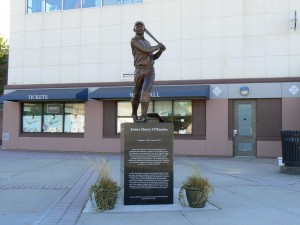 An open bronze book near his feet bears a quote attributed to O’Rourke, “Baseball is for all creeds and nationalities.” The open book is supported by representations of a volume of Shakespearian poetry as well as Blackstone’s Commentaries (an authoritative exploration of English Common Law).
An open bronze book near his feet bears a quote attributed to O’Rourke, “Baseball is for all creeds and nationalities.” The open book is supported by representations of a volume of Shakespearian poetry as well as Blackstone’s Commentaries (an authoritative exploration of English Common Law).
After his Major League career was over, O’Rourke was active in the professional Connecticut State League as an owner, manager and occasional player.
The dedication of the monument caps several years of efforts to honor O’Rourke. Efforts to convert the ballplayer’s former Pembroke Street home into a baseball museum ended when the house, long visible from Interstate 95 standing alone in a cleared area near the harbor, was demolished.
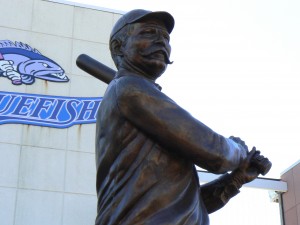 The statue stands outside the city’s Ballpark at Harbor Yard, home of the Independent League’s Bridgeport Bluefish.
The statue stands outside the city’s Ballpark at Harbor Yard, home of the Independent League’s Bridgeport Bluefish.
An exhibition running through January of 2011 at the Fairfield Museum and History Center provides a look at baseball’s history in the region.
Tags: Bridgeport
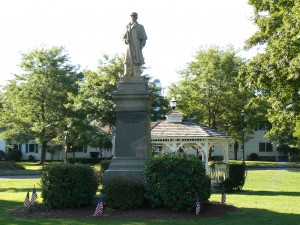 Wolcott honors veterans of the American Revolution, War of 1812 and the Civil War with a granite monument in a small park in the center of town.
Wolcott honors veterans of the American Revolution, War of 1812 and the Civil War with a granite monument in a small park in the center of town.
The Kenea Soldier’s Monument, dedicated in 1916, features an infantry soldier standing atop a relatively simple granite monument. A dedication on the monument’s north face reads, “Presented to the town of Wolcott by Leverett Dwight Kenea in memory of the soldiers who fought in the War of the Revolution, the War of 1812 and the Civil War. A.D. 1916.”
The monument’s other faces are free of lettering or ornamentation.
The soldier stands with a rifle in his right hand, an uncommon variation on the two-handed rifle grip usually seen in monuments with infantry figures. Also, the figure’s face appears slightly more mature than the figures seen in other monuments.
 The monument was donated to Wolcott by Leverett D. Kenea, a Wolcott native who invested in several successful Thomaston businesses and made a number of philanthropic donations.
The monument was donated to Wolcott by Leverett D. Kenea, a Wolcott native who invested in several successful Thomaston businesses and made a number of philanthropic donations.
The town green is also known as Kenea Park, and Kenea Avenue runs between the green and Town Hall.
The monument, supplied by the Thomas F. Jackson Company of Waterbury (which also supplied the Prospect Soldiers’ Monument) was unveiled during its dedication ceremony by Wolcott’s four surviving Civil War veterans.
At the east end of the green, a granite monument honors veterans of the two World Wars, Korea and Vietnam, as well as recent conflicts in the Persian Gulf. The monument was dedicated in 1982 with support from three civic organizations.
 At the western end of the green, a monument honors the service of local veterans in Operation Desert Storm in 1991.
At the western end of the green, a monument honors the service of local veterans in Operation Desert Storm in 1991.
Tags: Wolcott
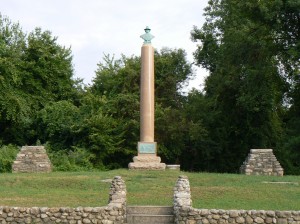 A large monument in Groton marks the original homestead of the local branch of the Avery family.
A large monument in Groton marks the original homestead of the local branch of the Avery family.
The monument, near the intersection of Poquonnock Road and Route 1, marks the site of the “Hive of the Averys,” where Captain James Avery built a homestead around 1650.
The site features a tall column topped by a bronze bust of Avery. A bronze plaque on the front (southeast) face of the monument’s base displays an image of the house. The northeast face lists the eight owners of the house between 1656 and 1894. The northwest face says the monument was built in 1895 by the Avery Memorial Association.
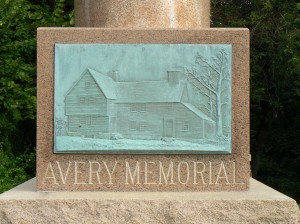 The southwest face of the monument’s base bears an inscription reading, “This memorial marks the site of the home built in 1656 by Captain James Avery, the founder of the family now known as the Groton Averys. This Hive of the Averys was owned and occupied by its famous builder until his death.
The southwest face of the monument’s base bears an inscription reading, “This memorial marks the site of the home built in 1656 by Captain James Avery, the founder of the family now known as the Groton Averys. This Hive of the Averys was owned and occupied by its famous builder until his death.
“Its later ownership and occupancy passed, in regular order of descent, from father to son, until it was burned on the night of July 20, 1894. Hinc illae lacrimae (Hence these tears).”
Steps from the original house and several other features can be seen at the site.
Captain James Avery moved to Groton from Gloucester, Mass., around 1650. In 1656, he commanded a company of Englishmen fighting Native Americans, and in 1684, he expanded the house. For the next 230 years, eight generations of Averys lived in the Hive.
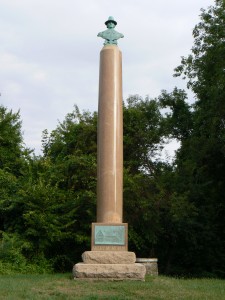 The arrival of the railroad to Groton ultimately meant the end for the Avery homestead. In 1894, sparks from a passing railroad engine set the house’s roof on fire, and the home was destroyed.
The arrival of the railroad to Groton ultimately meant the end for the Avery homestead. In 1894, sparks from a passing railroad engine set the house’s roof on fire, and the home was destroyed.
At the time of the fire, James Denison Avery was serving as Groton’s town clerk and, according to the custom of the era, recorded transactions and stored the town’s land records in his home. Fortunately, bound transaction volumes were protected in fireproof safes.
The monument was created by sculptor Bela Lyon Pratt, whose works included the Nathan Hale statue at Yale University.
More information about the Avery family, which has long been active in civic and business circles, at the Avery Memorial Association’s website.
Tags: Grot
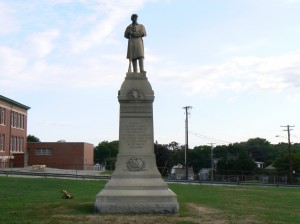 A monument next to the Fort Griswold battlefield honors Groton’s Civil War veterans.
A monument next to the Fort Griswold battlefield honors Groton’s Civil War veterans.
The Gray Soldiers’ Monument was a posthumous gift by Robert A. Gray, a Groton native and Civil War veteran who received a Medal of Honor for courage during fighting at Drewry’s Bluff, Virginia.
The monument, which features an infantryman standing atop a granite base, bears a dedication on its front (south) face reading, “Erected by Robert A. Gray and dedicated to the memory of his brave comrades who offered their lives for their country in the war of 1861-1865.”
The south face also bears the Connecticut and United States shields near its base, and also honors the battle of Fredericksburg, Va. The east face honors the battle of Port Hudson, La. Gettysburg is listed on the north face, and Drewry’s Bluff is honored on the west face.
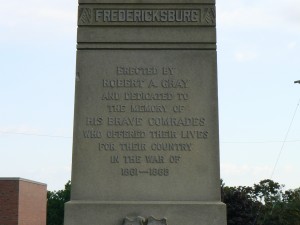 The monument was dedicated July 4, 1916, thanks to a posthumous donation. Robert A. Gray, a Groton stonecutter, had served with the 21st Regiment, Connecticut Volunteer Infantry. Gray was awarded the Medal of Honor for rescuing an injured officer during fighting at Drewry’s Bluff.
The monument was dedicated July 4, 1916, thanks to a posthumous donation. Robert A. Gray, a Groton stonecutter, had served with the 21st Regiment, Connecticut Volunteer Infantry. Gray was awarded the Medal of Honor for rescuing an injured officer during fighting at Drewry’s Bluff.
The Soldiers’ Monument, near the corner of Park Avenue and Smith Street, stands almost in the shadow of the Groton Battle Monument and museum in Fort Griswold State Park.
The monument was supplied by the Smith Granite Works in nearby Westerly, R.I., and may have been among the last Civil War monuments purchased from the firm.
Gray’s unit is honored with a monument in downtown New London’s Williams Memorial Park.
Tags: Groton
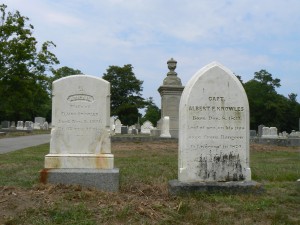 The maritime heritage of Brewster, Mass., is reflected in the number of sea captains, several lost at sea, who are honored in Brewster Cemetery.
The maritime heritage of Brewster, Mass., is reflected in the number of sea captains, several lost at sea, who are honored in Brewster Cemetery.
During a recent visit to the cemetery, on Lower Road, we found more than 13 graves bearing the names of local captains who were lost or died while abroad.
According to the 1906 book “Brewster Ship Masters” by J. Henry Sears, Brewster is believed to have supplied the most sea captains (as a percentage of population) of any town in the nation. By 1840, when the town’s population was about 1,000, more than 115 residents had captained a ship.
 In 1850, at the height of Brewster’s maritime prosperity, more than 50 captains were living in town at the same time.
In 1850, at the height of Brewster’s maritime prosperity, more than 50 captains were living in town at the same time.
The following excerpt from the book demonstrates the importance of international trade to Brewster:
In the [18]40’s and 50’s the young man born in Brewster, who did not go to sea as soon as his schooling was complete was a shiftless no-account, unfit to associate with the aristocracy. His comrades shipped as cabin-boys, under Brewster captains of their fathers’ acquaintance and with Brewster mates and many Brewster members of the crew, studied navigation, and, at ages ranging from twenty-one to twenty-five, became captains themselves.
As the following excerpt illustrates, the dependence on the sea was hard on Brewster families, and often ended unhappily:
Women and children saw husbands and fathers only at long intervals and waited for news of their arrival in far-off ports. Sometimes they waited, and when the news came it was in the form of a letter from a mate or a steward and told of a death and burial at sea…Many a stone in the Brewster cemetery has “lost at sea” carven on it and the mystery of that loss will always be a mystery.
 For example, Capt. Alfred F. Knowles was born in Brewster in 1839, and was lost along with the ship “Southern Eagle” after a typhoon struck during a voyage between Rangoon (the former capital of Myanmar, then known as Burma) and Liverpool in May of 1870.
For example, Capt. Alfred F. Knowles was born in Brewster in 1839, and was lost along with the ship “Southern Eagle” after a typhoon struck during a voyage between Rangoon (the former capital of Myanmar, then known as Burma) and Liverpool in May of 1870.
Similarly, Capt. Nathan F. Foster was a Brewster native who was born in 1833. He was on the ship “Centaur” when it caught fire in August 1874 during a trip between Liverpool and San Francisco. The crew made it onto three boats, but Foster was never heard from.
The fact that many families multiple members at sea meant some experienced tragedy more than once. Capt. Theophilus Berry and his wife Sarah lost Theophilus, Jr. in 1817 at the age of 16 and Capt. Isaac F. Berry in 1829 at the age of 24.
 According to the Sears book, the importance of the sea trade had passed by the end of the 19th Century and was gradually replaced by tourism as Brewster’s primary source of revenue. Instead of sailing to distant lands, Brewster’s youth has the safer choice of frying clam strips and scooping ice cream.
According to the Sears book, the importance of the sea trade had passed by the end of the 19th Century and was gradually replaced by tourism as Brewster’s primary source of revenue. Instead of sailing to distant lands, Brewster’s youth has the safer choice of frying clam strips and scooping ice cream.
Many of the former captain’s homes remain along Main Street and, together with the headstones standing atop empty graves in Brewster Cemetery, help today’s tourists understand the town’s maritime past.
Tags: Massachusetts
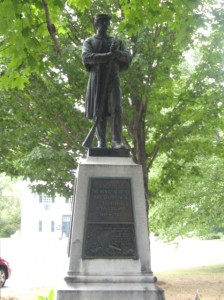 The Village of Newfane, Vermont, honors its war heroes and veterans with several monuments on the town common.
The Village of Newfane, Vermont, honors its war heroes and veterans with several monuments on the town common.
The 1916 Soldiers’ Monument honors veterans of the Civil War and World War I. The monument, near the intersection of Route 30 and Jail Street, features a bronze infantryman standing atop a granite base.
A dedication on the monument’s front (east) face reads, “In memory of the men of Newfane who served their country in the Civil War, 1861 – 1865.”
Immediately below the dedication plaque, another bronze plaque displays a Civil War scene as well as an excerpt from the “Bivouac of the Dead,” a poem by Theodore O’Hara that was used on numerous Civil War monuments and sites.
The north and south sides of the monument’s base feature plaques listing local residents who served in the Civil War.
The monument’s west face bears a plaque listing the names of 34 residents who served in World War I.
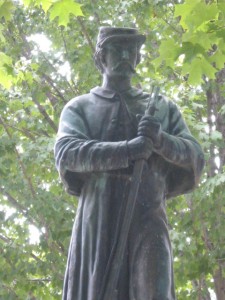 The infantry figure was supplied by the WH Mullins Company of Ohio, and the base was supplied by the CH Grant Granite Company.
The infantry figure was supplied by the WH Mullins Company of Ohio, and the base was supplied by the CH Grant Granite Company.
Not far from the Soldiers’ Monument, a bronze plaque mounted on a granite memorial honors Newfane’s World War II veterans. The plaque lists the names of 90 residents who served in the conflict, and highlights one who was killed.
Also nearby is a monument honoring Newfane’s veterans of the Korean and Vietnam wars. The Korean War section lists 30 residents who served. The Vietnam section honors 38 residents, including one who was killed in action.
Thanks for Mom and Dad for taking the photos.
Source: Smithsonian American Art Museum, Art Inventories Catalog
Tags: Vermont
 A New Haven site that’s hosted a series of forts now bears the name of American Revolution hero Nathan Hale.
A New Haven site that’s hosted a series of forts now bears the name of American Revolution hero Nathan Hale.
Fort Nathan Hale Park is a 20-acre historic and recreational site on the eastern shore of New Haven Harbor. The park features reconstructions of American Revolution and Civil War forts as well as a statue of Nathan Hale.
Black Rock Fort, which stands on the far edge of the site, is a recreated American Revolution fort from which 19 militia members fired cannons at British ships during the 1779 invasion of New Haven.
The English cannon mounted at the fort site was dedicated by a local DAR chapter in 1914.
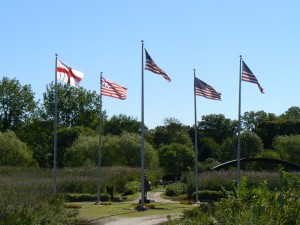 Near the Black Rock Fort site are two restored bombproof shelters that were part of the Civil War fort. Off-duty troops would have stayed in the shelters, which were guarded by large mounds of earth.
Near the Black Rock Fort site are two restored bombproof shelters that were part of the Civil War fort. Off-duty troops would have stayed in the shelters, which were guarded by large mounds of earth.
The fort was protected by a moat that was crossed by a drawbridge. The drawbridge opened and closed by sliding the center section, which rested on railroad-like tracks.
The site also features a statue of Nathan Hale in the center of a small courtyard ringed by flagpoles with the current U.S. flag as well as flags from the Colonial Era, the American Revolution, War of 1812, and the Civil War.
The Hale statue is a fiberglass copy of a 1914 figure by Bela Lyon Pratt at Yale University, from which Hale graduated in 1773. Another copy of the Lyon statue is displayed at the CIA headquarters building in Langley, Virginia.
 Hale, the official state hero, is also honored with a statue in New London and a bust in East Haddam (both communities in which he taught) as well as a statue at the state capitol building.
Hale, the official state hero, is also honored with a statue in New London and a bust in East Haddam (both communities in which he taught) as well as a statue at the state capitol building.
The Fort Nathan Hale site, next to a Coast Guard station, has seen several uses since it last hosted an active fort. In 1921, it was turned over to the City of New Haven, and it was used as a recreation area until it was damaged during the hurricane of 1938.
In the late 1960s, an effort was launched to restore the site in time for the U.S. bicentennial celebration in 1976.
Today, Fort Nathan Hale is open from 10 a.m. until 4 p.m. daily between Memorial Day and Labor Day.
Tags: New Haven


